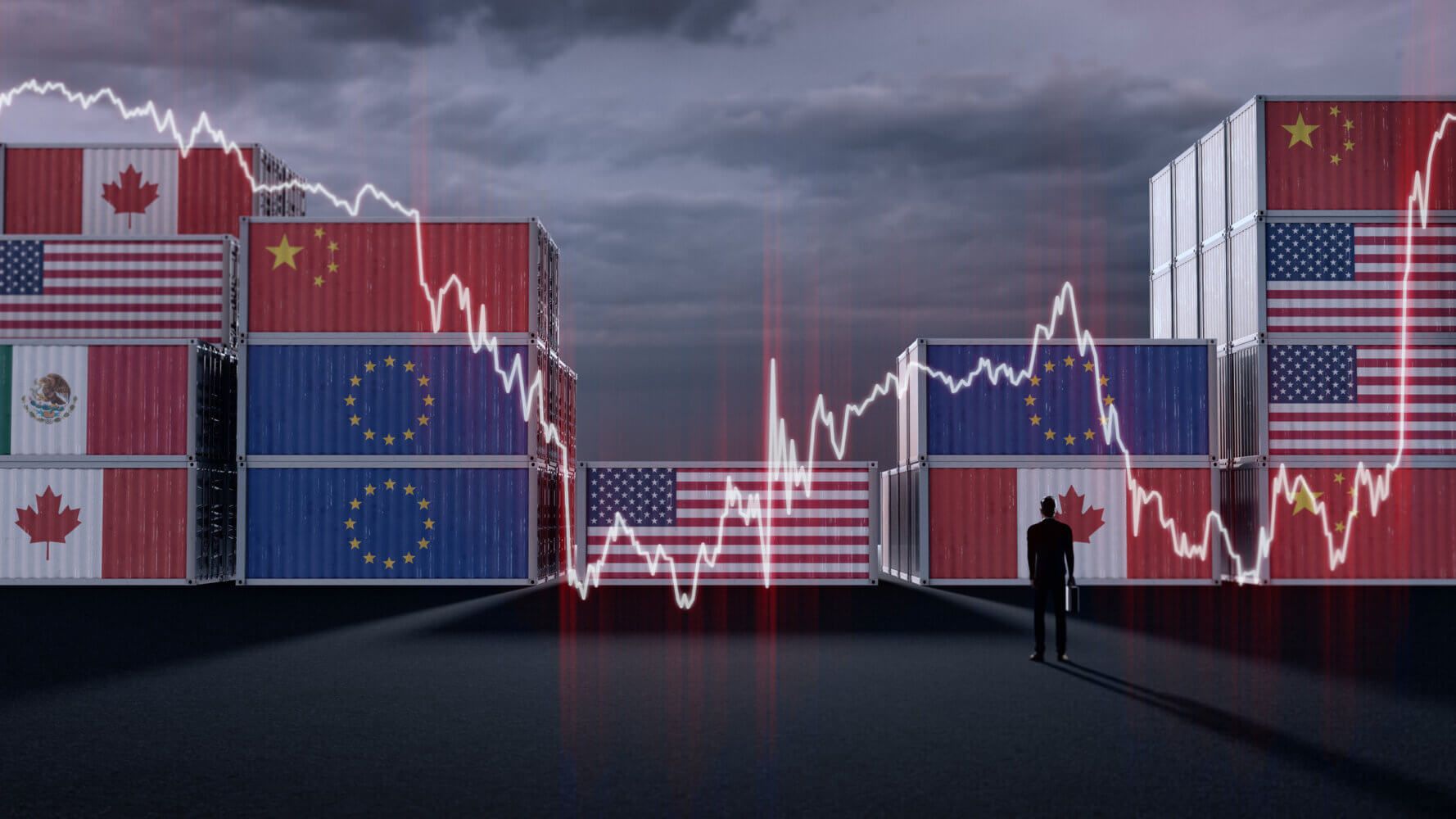
Thornburg’s client portfolio managers explore some of Wall Street’s biggest themes.
Tariffs, Stagflation, and the Fed: A Spotlight on Investors’ Most Pressing Questions
Josh Rubin: This is the CPM round table, where Thornburg client portfolio managers will discuss topics that are top of mind for investors. My name is Josh Rubin and I’m joined by Phil Gronniger and Ben Keating. And as client portfolio managers, we are engaged daily with both the investment team and clients, which gives us a unique insight into what’s top of mind.
Certainly, a topic of the year for the first half of the year has been tariffs. And Phil, what are you hearing? What are you thinking about the tariff situation today.
Phil Gronniger: Sure. The initial reaction from tariffs that escalated very rapidly in terms of what would be charged, if you will, was pretty scary. That’s come down. But initially the reaction is that things are going to be very inflationary, and consumers are going to take the hit on that, and that could lead to some retrenchment by consumers and leading to a lot of uncertainty at the business level as well. Particularly when it comes to corporate decision making and capital expenditures.
Ben Keating: Yeah, I’ll just add I mean, it’s obviously another policy, probably the most dramatic trade policy that we’ve had in 100 years. So, people knew it was coming. But the rollout was unorthodox. And other than the first two weeks of, you know, post-Liberation Day. I think what’s been most impressive is how well behaved the markets have been in, particularly the credit markets and what would ordinarily be a pretty good shock flight to quality. You’ve seen probably just the opposite, right. Dollar actually weakened. Continued to not as much yield collapse. Maybe yields went a little higher. So interesting I know we’re in the walk back phase. It’s a nice coin. And there’s still to be determined what the final phase will be. But I think versus what we were up against early days, I think the market has been amazingly well behaved based on a pretty dramatic event, dramatic event.
Josh Rubin: It’s funny, I think what’s been surprising to me is this feels a little bit like a hurricane, where there’s times where you have warning that a hurricane’s coming in and the news covers it every day, and then the hurricane passes over. But all the all the windows were but, you know, not buttoned down, I guess covered up and nothing bad actually happens. And there’s other times where even though everybody knows a hurricane’s coming and people prepare, things go badly, and Phil a little bit, everybody’s known this was coming since the election. Everybody’s known this was coming since, in advance of Liberation Day up and down. And we still there’s sort of this unease. Is it going to happen or not? But maybe this is a hurricane that passes by.
Phil Gronniger: To your point. And using that analogy, maybe that’s the, we’re in the eye of the hurricane right now, and we go to the other side of that hurricane. The storm picks up again. There’s some escalation in potential tariffs. Ultimately, we don’t know where they settle out, except that they will be higher than they were. And that could have some inflationary impact. We’ve seen when we look at CPI data, goods prices have actually been deflationary all of 2024 through the first couple of months this year. And more recently have slightly ticked up, adding back to the inflation figures that could go a little higher. But perhaps it, that second half of the hurricane isn’t so bad.
Josh Rubin: It’s, one thing we seem to be bumping into is it’s not totally clear where global inventories sit. And so, a number of companies, they may be the end reseller of products, or they may be the producer of products. But definitely, Asian manufacturers were moving inventory both into the US or at least into NAFTA. Before Liberation Day or continue to whenever they saw tariffs go back down again. And so, from a price hike standpoint, it does feel like we just don’t have genuine clarity. Are we just seeing inventories worked off right now or are we seeing the actual pass through.
Ben Keating: Yeah. And just of all the debates we’ve had with other friends and foes in the tariff debate, it’s China’s that is the real end game. That’s not going to go away after 90 days. They’ll be residual both economic and military issues there. But again, versus what you were perhaps up against, I’d say the relationship between U.S. and China is remarkably well behaved, even though it’s obviously adversarial. And that’s a positive for the markets. I think the markets are still watching. It’s still to be played out.
But so far, I think, you know, almost 90 days into it, the markets are fairly relieved. It could have been a lot worse based on early days.
Josh Rubin: We do see it. It seems like we’re in a reactive world in the sense that, the Trump administration is taking the first step on just about everything. And investors, foreign governments, companies are just reacting to it. So other than this element of pre-positioning inventories, foreign governments seem to be waiting to really understand what the Trump administration wants to do before they actually respond. You know, they may have had a game plan in advance, but it’s a very patient response from sort of all stakeholders in this equation, both as we proceed, or maybe even as they engage with each other.
A second topic that falls into this category of unpredictable fears or unproven fears is whether stagflation is a possibility. And in the context of stagflation, we all know the fed has the two mandates of both employment and economic growth. And actually, the funny thing right now is unemployment is sort of fine. I’m in a safe space and economic growth isn’t clearly weak. But everybody’s concerned about what the medium-term growth outlook is between inflation, between tariffs, you know, economic realignment and so on. What are you thinking on that, Ben?
Ben Keating: Yeah. I mean, the whole term stagflation, the three of us at the table have been doing this a long time, but even with our experience, we weren’t around for stagflation or heavy inflation. So, the Covid was kind of a unique time reminder of why inflation kind of showed up. Is the three main components energy, housing and labor were stretched. It just didn’t have enough supply and too much demand. And then obviously a big overlay of Covid related spending. So, to people who think static stagflation is around the corner, I respect that view.
I’d say most of our investors here at Thornburg are not in that camp, and that it would take a lot to get back to stagflation. If anything, any type of short-term inflation that may come from tariffs or supply chain, maybe still a tight labor that probably would show up, but then, there’s a lot more disinflation happening globally. And you got a fact that and it just the lagging indicators are okay. But leading indicators seem to be softening. So, I’d be very surprised if stagflation is a base case. But you have to respect that. We’re probably back to normal. So, I think the sense of you know what. What’s the historical parallel for inflation? To me this feels a lot more not like the 70s or early 80s but feels more like the 90s in the sense that we’re going back to normal.
And what does that mean based on curve? We’ll talk about curves and treasuries, but just upward sloping curve, kind of, you know, material rates or inflation. They may not get back to that core, that magic core number. But it’s just it’s going to have more inflation than what we used to in the prior 20 years, or at least from 2000 to 2020. Right? So, and that’s not a bad thing. We still had a great look at 1990s. It was a very productive year. Great returns, great productivity, great globalization. So, I think too many people are hung up on getting back to a deflationary spiral. We don’t want that. So, if we happen to have more normalized inflation without the stagflation, I think that’s actually not a bad thing.
Phil Gronniger: And following on Ben’s comments, we had exceptionally low inflation for so long. It was such a dramatic spike during Covid to get back to 40 year high and inflation, that there is some that projected that forward long term. It’s come down dramatically. It’s outside the Fed’s comfort zone a little bit. Still, we look at core PCE which said focus focuses on it 2.5%. They’d like to see it get back down to two. But we spent many years below that. So, 2.5% is not bad. We can chug along at decent economic growth. That’s really important to that equation of the potential for stagflation. We have seen decelerating growth, but not recessionary flashing indicators much. We’ve seen the ISMs dip just below 50 a little bit. Those are the diffusion indices above 50 expanding below 50 contracting but nothing to be overly concerned about the non-farm payrolls on a year-to-date of average 100 and 157,000, roughly on a year-to-date basis. That’s down from prior years. If we look over the year over year, back in 2022, we’re at 380,000. End of 24, we were about 170,000 for the average on the year. So again, decelerating, but not bad. You pointed out, Josh, that our unemployment’s still exceptionally low. You could say we’re at that full employment and we’ve got basic price stability with a low to handle or mid two handle on inflation.
Josh Rubin: I think that seems to be a complicated debate. Certainly. Both internally when we’re, laying out different, perspective outcomes, but also externally of which elements of inflation or growth are cyclical, which things are more secular or more structural. And so, you know, certainly goods prices are probably more cyclical, somewhat of a question of whether we import inflation with the depreciating currency or not. That was sort of a challenge for Japan in the early part of last decade, was they were weakening the currency. They did have inflation, but it was just the translation effect of a depreciating currency. So, what does that mean for the US? But the final part is, you know, from an inflationary standpoint, we’ve really had undersupply of a number of things since the financial crisis. So, we’d overbuilt housing then we’ve really had a decade plus of generally under building housing compared to population growth.
Globalization led to high building of kind of capital equipment outside the country. But if we really are going to onshore or near shore a lot more, maybe we, you know, we sort of have this prolonged cycle of needing more labor or needing more equipment for domestic manufacturing. And then the final part of just the labor question and how much of weak wages for a long time were driven by immigration.
And so, if we have a decrease in the population, while we’re, you know, have a weakening economy, you could actually have low unemployment and a weakening economy just because there’s fewer people to fill those jobs. And I know that was a little bit of a ramble, but it’s this funny balance where we have some cyclical factors that, you know, that drive this, but also uncertainty around maybe some structural factors, because housing probably needs lower interest rates to really get going again, but maybe we don’t have the labor supply to build more houses again, you know, some moving pieces like that. I don’t know if you guys have additional thoughts on those things.
Ben Keating: Yeah. I mean, housing is always interesting. It’s just a lot of people feel stricken. The ones that are benefited to have purchased the house at a low price and are locked into low mortgages. That’s it. That’s why you’re not seeing a lot. Although it is a recent trend, you are seeing more homes come on the market. And make sure when that sign tells again, it’s things can change quickly. But the good news is it doesn’t feel like versus what we’re up against in 07-08. It’s related to property, and it’s heavily tied towards GDP and labor. It doesn’t seem to be a house of cards right. There’s a lot more equity in the homes. But it’s just, you know, it’s an interesting time where you feel like there’s a change happening. A lot of the younger generation, they’re having trouble accessing homes, accessing maybe even loans. But that seems like there’s going to be some changes in the next 12 months.
Phil Gronniger: Yeah. Since in the housing inventory go up a little bit. But it’s a structurally different housing market than it was 07/08 you know, have the similar, individuals that own two and three homes that perhaps shouldn’t have that perhaps are the loans that didn’t have any background docs to them. When you think about the other part of that question to the labor force, to build the homes or labor force to do other jobs, that, might have been a relatively cheap labor force starting to disappear a little bit, population potentially declining.
You’ve got a different labor force participation rate that’s not come back to where it was pre-COVID. People left the job market didn’t come back. Now you’re having some changes with immigration policies and the potential for relatively inexpensive labor to start, fading away a little bit more. And that’s going to put a little bit of pressure on companies and potentially margins. At some point, though, it’s not dramatic right now. But something to watch out for, for a potential inflationary effect.
Josh Rubin: Maybe just to throw out something kind of a wrinkle in this. So, we just sort of started talking about why it’s less likely that there’ll be stagflation. Can either of you make a case for an acceleration in economic growth?
Ben Keating: Yeah. I mean, usually it’s whatever the consensus on the negative side, which is a fair bit rate policy uncertainty across the board. It’s not we’re talking we talk first about tariffs and trade. But you can say the same for fiscal and monetary. Right. Your big, beautiful bill looks to be likely. But you can see some wrinkles there. And then. Is the fed going to cut or are they going to stay pat. All those factor in, I think. But just one by one I mean if you get a more sound policy, more certainty either from fiscal and from tariffs or you can argue that’s probably not priced in if we get that sooner this summer, the markets like that, the market’s made it. It’s not a political statement. But they like less taxes like less regulation. And you see that on top of oh by the way there’s still early innings of a AI/tech arms race. And that just so it can be compounding. So, we saw some animal spirits last fall. I think a lot of people post-Covid are ready to kind of get back to work.
Frankly, if there’s that sense, don’t get me wrong, profound cultural and social changes going on. But from an economic standpoint, this is an amazing time to be alive. So that would be the backdrop. Whether that factors in this, this summer, this fall, that would if that you get those just slightly more tilted positive, you could get that inflow. But to be sure, I think as far as that showing up in the numbers, I would be surprised if you see a GDP pop this summer. I think there’s a fair amount of lagging numbers that’ll factor into us a softer economy already seeing softer numbers overseas. But this could be more for next spring/next summer, where you start to build the ground for a launchpad and get back to a fairly decent economic backdrop.
Phil Gronniger: Adding to that, removing that uncertainty, and getting through that back to the kind of the start of our, our discussion here, getting through the second part of that hurricane, we get certainty from a tariff standpoint. We get some, if you will, stronger negotiations with some other countries to settle where we’re going to ultimately end up on the tariffs and companies can start to plan for that. And we remove that ambiguity. You see that and you hear that in fed speak to and we’re going to talk a little bit more about Powell and the Fed. But there’s a lot of uncertainty in their decision making going on right now as well. They’re not sure how tariffs are going to impact things. That’s keeping them on hold for a little bit longer and similar with companies. Perhaps there’s the potential that we start to see more limited guidance in earnings. But you take out some of that uncertainty. Companies are going to start, I think, plan a little bit stronger. They’ll have the ability to forecast their capital expenditures a little bit better and stepping away from just, if you will, that uncertainty from potentially tariffs and administration. One other thing that could lead to some acceleration in growth. And I agree with Ben, not popping by any means, but certainly a little bit longer term is, continued increase in worker productivity. You started to see a lot of that evidence last year. And much of that comes from technology. Without getting deep in the weeds on AI helping drive things, more efficiency for companies, for individual workers to get more done. So perhaps that’s one reason we don’t need as much, if you will, labor force participation too, because worker productivity continues to rise. That can certainly accelerate growth a bit. Again, not popping it within the next quarter or two, but just longer upward momentum that staves off the potential for and we hear a lot in the potential for recession, just keeps us chugging along yet maybe it’s a low to handle on GDP or more recent forecast. We saw the fed adjust, raising their inflation and bringing their GDP growth numbers down a little bit. But perhaps we stay on a high 1% or even a low two handle on GDP growth.
Josh Rubin: Perfect. Well, maybe I’ll sort of just and finish in this pose a question to our listeners, which is from a productivity standpoint, is it actually the three of us talking or is this AI, Phil, AI, Ben and AI Josh having this discussion right now. All right. Great. Ben and Phil, thanks a lot for taking the time today. And we look forward to continuing the conversation. Again. This is a funny world where things change quickly, but also a lot of things stay the same. So, we’ll definitely have things to talk about in the future. And we’ll do this again sometime soon.
Ben Keating: Great. Happy to do it.
Phil Gronniger: Thank you, Josh. Thank you, Ben.
Important Information
The views expressed are subject to change and do not necessarily reflect the views of Thornburg Investment Management, Inc. This document is for informational purposes only and does not constitute a recommendation or investment advice and is not intended to predict the performance of any investment or market. It should not be construed as advice as to the investing in or the buying or selling of securities, or as an activity in furtherance of a trade in securities.
This is not a solicitation or offer for any product or service or an offer or solicitation for the purchase or sale of any financial instrument, product or service sponsored by Thornburg or its affiliates. Nor is it a complete analysis of every material fact concerning any market, industry, or investment. Data has been obtained from sources considered reliable, but Thornburg makes no representations as to the completeness or accuracy of such information and has no obligation to provide updates or changes. Thornburg does not accept any responsibility and cannot be held liable for any person’s use of or reliance on the information and opinions contained herein. The views expressed herein may change at any time after the date of this publication. There is no guarantee that any projection, forecast or opinion in this material will be realized.
Investments carry risks, including possible loss of principal.
More Insights

Finding Opportunity Amid Imbalance: 2026 Market Outlook

Thornburg Income Builder Opportunities Trust Announces Distribution

Ferrari’s Electric Future and the Evolution of Luxury Investing

FOMC Update: Fed Approves Third Consecutive Rate Cut, Projects Slower Pace

Luxury Brands Navigate China Slowdown and Tariff Pressures



